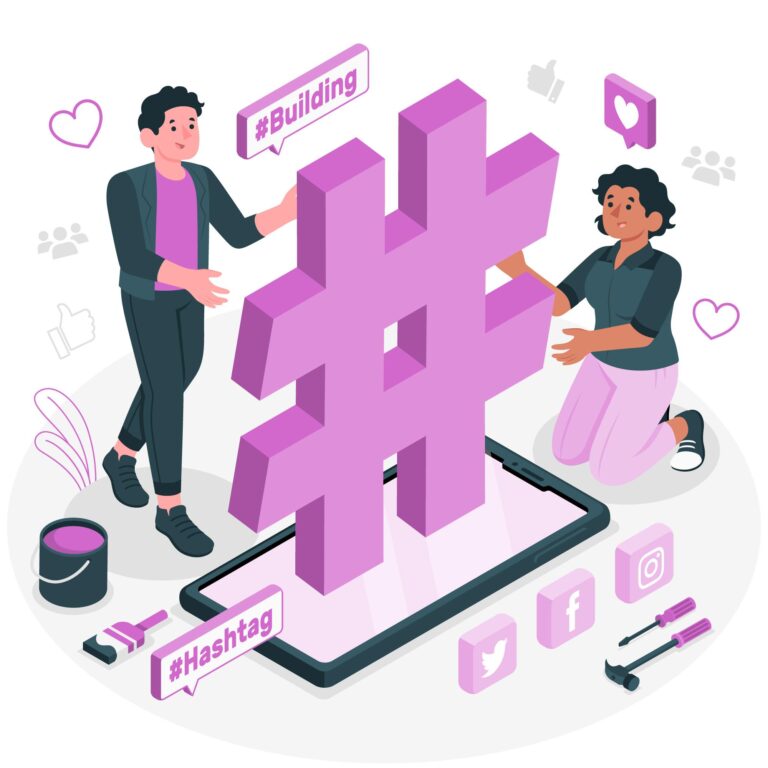In today’s digital age, social media has become a powerful tool for businesses to reach out and connect with their target audience. For t-shirt businesses, in particular, Tshirt brand social media marketing has proven to be an effective way to showcase their products and engage with potential customers.
With the rise of e-commerce platforms and online shopping habits, t-shirt businesses have had to adapt their marketing strategies to stay competitive. Social media platforms such as Instagram, Facebook, Twitter, and Pinterest provide ample opportunities for these businesses to promote their brand and sell more products. In this article, we will explore how t-shirt businesses can leverage social media marketing to boost sales and grow their customer base.
Table of Contents
Overview of social media marketing for t-shirt business
Social media has become an indispensable tool for businesses of all sizes and industries, and the t-shirt industry is no exception. With over 3 billion active social media users worldwide, platforms like Facebook, Instagram, Twitter and Pinterest present a unique opportunity for t-shirt businesses to connect with potential customers and promote their brand.
Social media marketing can help t-shirt businesses increase their visibility, drive traffic to their website, engage with their target audience, build brand loyalty, and boost sales. But with so many different platforms available and so much content being shared every second, it can be challenging to know where to start.
Setting up social media accounts
Social media platforms have become an integral part of our daily lives. It is the perfect medium to connect with friends, family, and even strangers on a global level. With the increasing number of users on these platforms, businesses are also utilizing social media channels to promote their brands and engage with their audience.
Setting up social media accounts has become crucial for businesses to increase their online presence and reach a wider target audience. Many successful businesses have leveraged the power of social media to boost their sales funnel and build customer loyalty. In this article, we will discuss the importance of setting up social media accounts for your business and how it can benefit you in the long run.
Setting up social media accounts is a fairly straightforward process.
Here’s a general guide on how to set up accounts on some popular social media platforms:
- Go to www.facebook.com.
- Fill out the required information, including your name, email or phone number, password, date of birth, and gender.
- Click on “Sign Up” to create your account.
- Follow the on-screen instructions to add a profile picture, find friends, and customize your profile.
- Visit www.twitter.com.
- Click on “Sign Up” to create a new account.
- Enter your name, phone number or email, and password.
- Click on “Sign Up” again.
- Follow the prompts to customize your profile, add a profile picture, and start following other users.
- Download the Instagram app from your device’s app store (available for iOS and Android).
- Open the app and tap on “Sign Up.”
- Enter your email address or phone number and tap “Next.”
- Create a username and password for your account.
- Complete your profile by adding a profile picture and providing some basic information about yourself.
- You can also connect your account to your Facebook or Twitter profile to find friends.
- Visit www.linkedin.com.
- Click on “Join now” or “Sign Up.”
- Enter your first name, last name, email address, and password.
- Click on “Agree & Join” to create your account.
- Follow the prompts to add your professional information, such as your job history, education, and skills.
- Customize your profile by adding a professional photo and personalizing your headline and summary.
- YouTube
- Go to www.youtube.com.
- Click on “Sign In” at the top right corner.
- Choose the “Create account” option.
- Fill out the required information, including your name, email address, and password.
- Click on “Next” and follow the on-screen instructions to complete your account setup.
- Customize your channel by adding a profile picture, channel art, and writing a channel description.
Remember to read and understand the terms of service and privacy policy of each platform you’re signing up for. Additionally, consider adjusting the privacy settings and sharing preferences according to your preferences once your accounts are set up.
Which social media platforms to use for t-shirt business social media marketing

For a t-shirt business, there are several social media platforms that can be effective for social media marketing.
Here are some platforms you should consider:
- Facebook: Facebook is a popular and versatile platform that allows you to create a business page to promote your t-shirt business. You can share photos of your t-shirts, run targeted ads, engage with your audience through comments and messages, and even sell your products directly through the platform.
- Instagram: Instagram is highly visual and ideal for showcasing your t-shirt designs. You can create an Instagram business account and share high-quality images of your t-shirts, along with creative captions and relevant hashtags. Instagram also offers features like Stories, IGTV, and Instagram Shopping, which can be utilized to promote and sell your t-shirts.
- Pinterest: Pinterest is a platform where users discover and save ideas. It can be particularly useful for showcasing your t-shirt designs and driving traffic to your online store. Create visually appealing pins that link back to your website or product pages, and utilize keywords and descriptions to optimize discoverability.
- Twitter: Twitter can be used to engage with your audience, share updates about your t-shirt business, and participate in relevant conversations. Use hashtags related to t-shirts, fashion, and your target audience’s interests to increase visibility. Twitter also allows you to share images, videos, and links to your online store.
- YouTube: YouTube is a video-sharing platform that can be utilized to create engaging content related to your t-shirt business. You can create videos showcasing your designs, behind-the-scenes footage, styling tips, and more. Building a YouTube presence can help you connect with your audience on a deeper level and drive traffic to your website.
- TikTok: TikTok is a rapidly growing platform that primarily focuses on short-form videos. It can be an excellent platform for showcasing your t-shirt designs in a creative and entertaining way. Experiment with popular trends, challenges, or create your own unique content to engage with the TikTok community.
Remember, it’s important to research and understand your target audience to determine which social media platforms they are most active on. It’s generally better to focus on a few platforms where you can consistently create quality content and engage with your audience effectively rather than spreading yourself too thin across multiple platforms. Must check our social media management services now!
Creating engaging content

Engaging content plays a crucial role in the success of your social media marketing efforts.
Here are some reasons why engaging content is important:
- Captures attention: In today’s fast-paced digital world, attention spans are shorter than ever. Engaging content helps you capture and hold the attention of your target audience amidst the sea of information competing for their attention. It allows you to stand out, pique curiosity, and make a memorable impression.
- Builds brand awareness: Engaging content helps increase your brand’s visibility and reach. When your content is interesting, valuable, or entertaining, people are more likely to share it with their networks, exposing your brand to a wider audience. This can lead to increased brand awareness and potentially attract new customers.
- Drives audience engagement: Engaging content encourages audience interaction and participation. When people find your content interesting, they are more likely to like, comment, and share it, which helps boost engagement metrics. This engagement not only strengthens your relationship with existing customers but also attracts new followers and potential customers.
- Establishes brand identity and loyalty: Engaging content allows you to showcase your brand’s personality, values, and unique selling points. It helps you establish a distinctive brand identity and fosters an emotional connection with your audience. When people feel connected to your brand, they are more likely to become loyal customers and advocates.
- Increases conversion rates: Engaging content has the potential to influence purchasing decisions. When your content resonates with your target audience, builds trust, and provides value, it can positively impact their buying behavior. Engaging content can drive traffic to your website, increase product inquiries, and ultimately lead to higher conversion rates.
- Encourages customer retention: Engaging content keeps your existing customers interested and connected to your brand. By consistently providing valuable and enjoyable content, you nurture customer relationships, foster loyalty, and increase the chances of repeat purchases. Satisfied and engaged customers are more likely to become brand advocates and refer others to your business.
- Supports word-of-mouth marketing: Engaging content is highly shareable, which can amplify the reach of your brand’s message. When people find your content valuable or entertaining, they are more likely to share it with their friends, family, and social media followers. This word-of-mouth marketing can significantly expand your brand’s reach and credibility.
Overall, engaging content is a powerful tool for building brand awareness, driving engagement, increasing conversions, and fostering customer loyalty. By investing time and effort into creating content that captivates and resonates with your target audience, you can significantly enhance the effectiveness of your social media marketing strategy.
Here are the ways to create engaging content for a t-shirt social media marketing campaign:
Creating engaging content for t-shirt social media marketing is crucial to attract and retain your audience’s attention.
Here are some effective ways to create engaging content:
- High-quality product photography: Invest in professional product photography that showcases your t-shirts in the best possible way. Use attractive visuals, proper lighting, and different angles to capture the details and unique features of your designs.
- Lifestyle and user-generated content: Encourage your customers to share photos of themselves wearing your t-shirts. Repost and share user-generated content to showcase real people enjoying and styling your products. This creates a sense of community and authenticity around your brand.
- Behind-the-scenes content: Take your audience behind the scenes of your t-shirt business. Share photos or videos of the design process, printing, packaging, or introduce the people behind the brand. This helps humanize your business and build a connection with your audience.
- Videos: Incorporate videos into your social media strategy. Create short videos showcasing your t-shirts, sharing styling tips, or telling the story behind a particular design. Videos tend to be highly engaging and shareable, allowing you to showcase your creativity and brand personality.
- Contests and giveaways: Organize contests or giveaways to generate excitement and engagement. Ask your audience to share their favorite design, tag friends, or use a specific hashtag to enter. This not only increases engagement but also helps spread awareness about your brand.
- Influencer collaborations: Partner with relevant influencers or micro-influencers in your niche. They can help promote your t-shirts to their followers, providing social proof and expanding your reach. Ensure the influencers align with your brand values and have an engaged audience.
- Polls and interactive content: Use features like Instagram Stories’ polls, quizzes, or question stickers to engage your audience. Ask for their opinions on new designs, color options, or t-shirt slogans. This allows your audience to feel involved and gives you valuable insights into their preferences.
- Educational and inspirational content: Share informative and inspiring content related to your niche. For example, you can create posts about fashion tips, sustainability in the fashion industry, or highlight the positive impact of purchasing your eco-friendly t-shirts. Providing value beyond just promoting your products helps build trust and loyalty with your audience.
Remember to tailor your content to each social media platform and use appropriate hashtags to increase visibility. Regularly analyze your social media analytics to understand what type of content performs best and resonates with your audience. Experiment, be creative, and consistently engage with your audience to build a strong online presence for your t-shirt business.
Types of content, visuals, captions, and hashtags for tshirt social media marketing campaign

When planning a t-shirt social media marketing campaign, it’s important to diversify your content to keep your audience engaged. Here are some types of content, visuals, captions, and hashtags you can use:
Types of Content:
- Product Photos: Share high-quality images of your t-shirts showcasing different designs, colors, and styles. Experiment with creative compositions, flat lays, or lifestyle shots to make your products visually appealing.
- Lifestyle Photos: Feature your t-shirts in real-life settings or on models to help your audience envision how they can incorporate them into their own style and daily lives.
- Behind-the-Scenes: Provide a glimpse into your t-shirt creation process, from design sketches to printing and packaging. This helps humanize your brand and build a connection with your audience.
- User-Generated Content: Repost and share photos of customers wearing your t-shirts. Encourage them to use a branded hashtag and tag your account to increase user engagement and generate social proof.
- Video Content: Create short videos showcasing your t-shirts, such as styling tips, tutorials, or showcasing the uniqueness of your designs. You can also consider creating animated or stop-motion videos to add an element of creativity.
Visuals:
- Use visually appealing and well-composed images that highlight your t-shirts.
- Maintain consistency in your visual style, such as color schemes or filters, to create a cohesive brand identity.
- Consider incorporating graphics, illustrations, or typography that align with your t-shirt designs and brand aesthetic.
Captions:
- Keep captions concise, engaging, and on-brand.
- Share the story behind the design, the inspiration, or the meaning behind each t-shirt.
- Ask questions, encourage comments, or prompt users to tag their friends or share their opinions on specific designs.
- Utilize humor, puns, or clever wordplay when appropriate to add personality to your captions.
Hashtags:
- Use relevant hashtags that are specific to your t-shirt business, such as #tshirtfashion, #tshirtlovers, or #tshirtdesigns.
- Research and include popular and trending hashtags related to fashion, style, or specific design themes.
- Create branded hashtags that are unique to your brand and encourage your audience to use them when sharing their t-shirt photos.
- Participate in industry-related hashtag challenges or trends to increase your visibility and engagement.
Remember to analyze your social media analytics to identify which types of content, visuals, captions, and hashtags are resonating the most with your audience. Adapt and refine your content strategy based on the feedback and engagement you receive to continuously improve your social media marketing campaign.
Running ads on social media for tshirt social media marketing
Running ads on social media is an effective strategy for promoting your t-shirt business and reaching a wider audience.
Here are some steps to follow when running ads for your t-shirt social media marketing campaign:
- Define your advertising goals: Determine the specific objective of your ad campaign. Is it to drive website traffic, increase sales, promote a new collection, or boost brand awareness? Clearly defining your goals will help you create targeted and focused ads.
- Choose the right social media platform: Select the social media platforms that align with your target audience and campaign objectives. Facebook, Instagram, and Pinterest are popular platforms for t-shirt businesses due to their broad reach and targeting options.
- Set up an advertising account: Create an advertising account on your chosen social media platform. You may need to provide billing information and other account details during the setup process.
- Select the ad objective: Choose the specific ad objective that aligns with your campaign goals. The available options may vary depending on the platform but commonly include objectives like traffic, conversions, engagement, or brand awareness.
- Define your target audience: Identify your target audience based on demographics, interests, behaviors, or other relevant criteria. Utilize the targeting options provided by the platform to narrow down your audience and ensure your ads are shown to the right people.
- Set your budget and schedule: Determine your ad budget and select the duration for running your ads. You can choose between a daily budget or a lifetime budget, depending on your preference and campaign requirements.
- Create compelling ad visuals: Develop visually appealing ad creatives that showcase your t-shirt designs. Use high-quality images or videos that capture attention and accurately represent your products. Ensure that your visuals align with the platform’s recommended specifications.
- Write compelling ad copy: Craft persuasive and concise ad copy that communicates the unique selling points and value of your t-shirts. Highlight key features, promotions, or any other compelling messages. Include a clear call-to-action (CTA) that encourages users to take the desired action.
- Choose the ad format: Select the appropriate ad format for your campaign. This may include image ads, carousel ads, video ads, collection ads, or story ads, depending on the platform you are using. Consider the format that best showcases your t-shirts and resonates with your target audience.
- Add tracking and conversion pixels: Set up tracking and conversion pixels provided by the social media platform or integrate third-party tracking tools to measure the performance and effectiveness of your ads. This will allow you to gather valuable data and insights for optimization.
- Review and launch your ads: Before launching your ads, thoroughly review all elements, including visuals, copy, targeting, and settings, to ensure accuracy and alignment with your campaign goals. Once you’re satisfied, launch your ads and monitor their performance.
- Monitor, analyze, and optimize: Regularly monitor the performance of your ads using the analytics provided by the social media platform. Analyze key metrics such as impressions, reach, click-through rates (CTR), conversions, and return on ad spend (ROAS). Make data-driven optimizations, such as adjusting targeting, visuals, copy, or bidding strategies, to improve ad performance.
Remember to comply with the advertising guidelines and policies set by each social media platform to ensure your ads are approved and displayed effectively. Regularly review and optimize your ad campaigns to maximize their impact and achieve your marketing goals.
How to Set Up Facebook And Instagram ads for Tshirts Business?
To set up ads on Facebook, follow these steps:
- Create a Facebook Ads Manager account: Go to business.facebook.com/adsmanager and click on “Create Account.” Follow the prompts to set up your Ads Manager account. If you already have a Facebook Business Manager account, you can access Ads Manager through it.
- Set up your Facebook Business Page: If you haven’t already, create a Facebook Business Page for your t-shirt business. This will serve as the foundation for running ads on Facebook.
- Access Ads Manager: Once you have an Ads Manager account, go to business.facebook.com/adsmanager or click on the “Ads Manager” tab in your Facebook Business Manager.
- Select your campaign objective: In Ads Manager, click on the “+ Create” button to start a new ad campaign. Choose your campaign objective based on your advertising goals, such as brand awareness, traffic, conversions, or engagement.
- Define your audience: Set the targeting options for your ad campaign. Define your target audience based on demographics, interests, behaviors, or custom audience options like website visitors or customer email lists.
- Set your budget and schedule: Choose your ad budget and select whether you want to run your ads continuously or for a specific start and end date. Determine if you want to use a daily budget or a lifetime budget for your campaign.
- Choose your ad format: Select the ad format that best showcases your t-shirt designs and resonates with your audience. Facebook offers various formats, including single image ads, carousel ads, video ads, collection ads, or slideshow ads.
- Create your ad content: Upload or choose the visuals for your ad, such as images or videos. Write compelling ad copy that highlights the unique selling points of your t-shirts and includes a clear call-to-action (CTA).
- Configure ad placement: Decide where you want your ads to be displayed. Facebook offers automatic placements, or you can choose specific placements such as the Facebook News Feed, Instagram feed, Audience Network, or Messenger.
- Add tracking and conversion pixels: Set up the Facebook Pixel on your website to track conversions and gather valuable data. This will allow you to measure the performance of your ads and optimize your campaigns.
- Review and launch your ads: Carefully review all elements of your ad, including visuals, copy, targeting, and settings, to ensure accuracy and alignment with your campaign goals. Once you’re satisfied, click on “Publish” to launch your ads.
- Monitor, analyze, and optimize: Regularly monitor the performance of your ads using Facebook Ads Manager. Analyze key metrics like impressions, reach, CTR, conversions, and ROAS. Make data-driven optimizations to improve ad performance and achieve your advertising goals.
Remember to comply with Facebook’s advertising policies and guidelines to ensure your ads are approved and displayed effectively. Continuously test and refine your ads based on performance data to maximize their impact and drive results for your t-shirt business.
Targeting Options and ad formats in Social Media
Targeting options and ad formats vary across different social media platforms. Here are some commonly used targeting options and ad formats on popular social media platforms:
- Facebook:
- Targeting options: Facebook offers a wide range of targeting options, including demographics (age, gender, location), interests, behaviors, connections, custom audiences (based on email lists or website visitors), lookalike audiences (similar to your existing customers), and more.
- Ad formats: Facebook offers various ad formats, such as single image ads, carousel ads (multiple images or videos in a swipeable format), video ads, collection ads (a combination of images and videos), slideshow ads, instant experience ads (formerly known as Canvas ads), and lead ads (forms directly within the ad).
- Instagram:
- Targeting options: Since Instagram is owned by Facebook, it leverages the same targeting options available on Facebook. You can target users based on demographics, interests, behaviors, and more.
- Ad formats: Instagram offers similar ad formats to Facebook, including single image ads, carousel ads, video ads, and collection ads. Additionally, there are specific ad formats tailored to Instagram, such as Instagram Stories ads (full-screen vertical ads within Stories) and Explore ads (ads shown when users are browsing the Explore tab).
- Twitter:
- Targeting options: Twitter provides targeting options based on demographics, interests, followers (targeting specific accounts or followers of certain accounts), keywords, behaviors, and events.
- Ad formats: Twitter offers various ad formats, including promoted tweets (ads that appear in users’ feeds), promoted accounts (accounts suggested to users who share similar interests), promoted trends (hashtags promoted at the top of the trends list), and video ads.
- LinkedIn:
- Targeting options: LinkedIn allows targeting based on professional attributes, such as job title, company, industry, skills, education, and more. You can also target by demographics, including age, gender, and location.
- Ad formats: LinkedIn offers sponsored content ads (native ads that appear in users’ feeds), sponsored InMail (personalized messages sent to users’ LinkedIn inboxes), text ads (small text-based ads shown on the sidebar), and dynamic ads (highly personalized ads based on user data).
- Pinterest:
- Targeting options: Pinterest provides targeting options based on interests, keywords, demographics, and behaviors. You can target users interested in specific topics or those who have engaged with certain types of content.
- Ad formats: Pinterest offers various ad formats, including standard pins (single image or video ads), carousel pins (multiple images or videos in a swipeable format), shopping ads (product pins with pricing and availability information), and promoted video pins.
- Snapchat:
- Targeting options: Snapchat allows targeting based on demographics, interests, behaviors, location, and device-specific targeting.
- Ad formats: Snapchat offers ad formats such as single image or video ads, collection ads (multiple images or videos in a swipeable format), story ads (full-screen vertical ads within Stories), augmented reality (AR) lenses, and filters.
It’s important to note that each platform has its own specific features, targeting capabilities, and ad formats. When planning your social media advertising strategy, consider your target audience, campaign objectives, and which platforms align best with your business goals.
Influencer marketing for tshirt business
Influencer marketing can be an effective strategy for promoting your t-shirt business and reaching a wider audience.
Here’s a guide to implementing influencer marketing for your t-shirt business:
- Identify relevant influencers: Look for influencers whose audience aligns with your target market. Consider factors such as their niche, follower demographics, engagement rate, and overall brand alignment. Use social media platforms, influencer marketing platforms, or conduct manual research to find suitable influencers.
- Establish goals and objectives: Determine what you want to achieve through influencer marketing. It could be increasing brand awareness, driving traffic to your website, generating sales, or building brand credibility. Clear goals will help you choose the right influencers and track the success of your campaigns.
- Reach out to influencers: Once you’ve identified potential influencers, reach out to them with a personalized message. Express your interest in collaborating and explain why you believe they would be a good fit for your t-shirt business. Be clear about your expectations, campaign details, and compensation (if applicable). Building a mutually beneficial relationship is key.
- Collaborate on content creation: Work closely with the influencers to develop engaging and authentic content that showcases your t-shirts. Provide clear guidelines on the key messages, desired tone, and any specific details you want to highlight. Encourage the influencers to share their personal experiences and opinions about your t-shirts to make the content more genuine.
- Offer incentives: Incentivize influencers to promote your t-shirt business by offering free t-shirts, exclusive discounts, affiliate programs, or monetary compensation. The incentives should align with the value they bring to your brand and the size of their audience.
- Track and measure performance: Set up tracking mechanisms to monitor the performance of your influencer campaigns. Track metrics such as engagement rates, website traffic, conversions, and sales attributed to the influencers’ efforts. This data will help you assess the effectiveness of your campaigns and make informed decisions for future collaborations.
- Foster ongoing relationships: Building long-term relationships with influencers can be beneficial for your t-shirt business. Continuously engage with influencers, appreciate their efforts, and consider repeat collaborations or ambassador programs. This can lead to more authentic and consistent brand advocacy.
- Leverage user-generated content: Encourage influencers and their followers to create user-generated content featuring your t-shirts. Repost and share this content on your own social media accounts to amplify reach, social proof, and engage your audience. User-generated content adds credibility and authenticity to your brand.
- Stay compliant with regulations: Ensure compliance with relevant advertising regulations and guidelines. Disclose any sponsored content or partnerships with influencers as required by law to maintain transparency with your audience.
Remember, successful influencer marketing campaigns require careful planning, genuine collaborations, and a focus on building authentic connections with both influencers and their followers. By partnering with the right influencers, you can effectively leverage their influence to promote your t-shirt business and attract more customers.
Finding the right influencers and building partnerships
Finding the right influencers and building partnerships for your t-shirt business requires careful research and consideration.
Here are some steps to help you find and establish partnerships with influencers:
- Define your target audience: Understand your target audience’s demographics, interests, and preferences. This will help you identify influencers whose followers align with your ideal customer profile.
- Research relevant influencers: Use social media platforms, influencer marketing platforms, or manual research to find influencers who cater to your target audience. Look for influencers in the fashion, lifestyle, or niche categories related to your t-shirt designs.
- Evaluate influencer credibility: Assess an influencer’s credibility by examining their follower count, engagement rate (likes, comments, shares), quality of content, and authenticity. Look for influencers who have genuine and engaged followers, rather than those with inflated follower numbers.
- Analyze influencer content: Review the influencer’s past content to ensure it aligns with your brand values, aesthetics, and messaging. Consider their style, tone, and the overall quality of their content. Look for influencers who can effectively showcase your t-shirts in a way that resonates with their audience.
- Check for audience relevance: Examine the influencer’s audience demographics to ensure they match your target market. Look for influencers whose followers share similar interests, age group, location, and lifestyle. This will maximize the impact of your campaigns.
- Engage with influencers: Once you’ve identified potential influencers, start engaging with them by following, liking, and commenting on their posts. Build a genuine relationship and show interest in their content. This can help establish a connection and increase the likelihood of a positive collaboration.
- Reach out with a personalized message: Send a personalized message to the influencers expressing your interest in collaborating. Be specific about why you chose them, highlight the value they can bring to your t-shirt business, and explain how the collaboration will benefit both parties. Personalization is key to standing out and showing that you’ve done your research.
- Offer incentives: Incentives can motivate influencers to work with your brand. Consider offering free t-shirts, exclusive discounts, affiliate programs, or monetary compensation. The incentives should be fair and aligned with the influencer’s reach and value they provide.
- Establish clear expectations: Clearly communicate your expectations, campaign details, and deliverables to the influencers. Provide guidelines on the content format, key messages, usage rights, and disclosure requirements. Transparency and clarity will help ensure a smooth partnership.
- Nurture the relationship: Once the collaboration begins, maintain open communication with the influencer. Provide support, respond promptly to their queries, and show appreciation for their efforts. Building a strong relationship can lead to long-term partnerships and more impactful campaigns.
- Measure campaign performance: Track the performance of your influencer campaigns by monitoring key metrics such as engagement, website traffic, conversions, and sales. Analyze the data to evaluate the success of the collaboration and make informed decisions for future partnerships.
Remember, authenticity, alignment with your brand values, and genuine connections with influencers are crucial for successful partnerships. By carefully selecting influencers who resonate with your target audience and nurturing those relationships, you can effectively leverage influencer marketing to promote your t-shirt business.
Affiliate Marketing for Tshirt Business
Affiliate marketing can be a powerful strategy for promoting your t-shirt business and driving sales. It involves partnering with affiliates who promote your products and earn a commission for each sale they generate.
Here’s a guide to implementing affiliate marketing for your t-shirt business:
- Set up an affiliate program: Start by establishing an affiliate program for your t-shirt business. You can use affiliate marketing platforms like ShareASale, CJ Affiliate, or set up your own program using affiliate management software. Define the commission structure, cookie duration, and any specific terms or conditions.
- Recruit affiliates: Reach out to potential affiliates who align with your target audience and have influence in your niche. This can include bloggers, social media influencers, content creators, or website owners. Use affiliate networks, search engines, social media, or industry forums to find potential affiliates.
- Provide promotional materials: Equip your affiliates with promotional materials to effectively market your t-shirts. This can include high-quality product images, banners, text links, coupon codes, and any other assets that can be used on their websites or social media channels. Make it easy for affiliates to access and use these materials.
- Offer competitive commissions: Provide attractive commission rates to incentivize affiliates. Consider offering a percentage of each sale or a fixed amount per sale. Ensure that the commission structure is competitive within your industry to attract quality affiliates.
- Track affiliate sales: Use affiliate tracking software to accurately track and attribute sales generated by affiliates. This software assigns unique affiliate links or coupon codes to each affiliate, allowing you to track their performance and calculate commissions accurately.
- Provide affiliate support: Offer support and guidance to your affiliates. Respond to their queries promptly, provide resources and marketing tips, and help them optimize their promotional efforts. Building a strong relationship with your affiliates can lead to increased loyalty and more effective promotion of your t-shirts.
- Regularly communicate with affiliates: Keep your affiliates informed about new product launches, promotions, or any updates related to your t-shirt business. Regularly communicate with them through newsletters, emails, or a dedicated affiliate portal to keep them engaged and motivated.
- Monitor affiliate performance: Continuously monitor the performance of your affiliates. Track key metrics such as the number of clicks, conversions, conversion rates, and sales generated by each affiliate. Identify top-performing affiliates and optimize your program based on their success strategies.
- Reward and incentivize top performers: Recognize and reward your top-performing affiliates. Offer performance-based incentives such as higher commission rates, exclusive discounts, or bonuses. This can motivate affiliates to continue promoting your t-shirts and attract more high-quality affiliates to your program.
- Ensure compliance and transparency: Comply with advertising regulations and guidelines when implementing affiliate marketing. Ensure that your affiliates clearly disclose their affiliate relationship with your business when promoting your products. Transparency builds trust and maintains the integrity of your affiliate program.
- Regularly evaluate and optimize: Continuously evaluate the performance of your affiliate marketing efforts. Identify areas for improvement, optimize your promotional materials, test different strategies, and refine your commission structure. Regularly review the performance of affiliates and make necessary adjustments to maximize results.
Affiliate marketing can expand your reach, increase brand exposure, and drive sales for your t-shirt business. By cultivating strong relationships with affiliates and providing them with the necessary resources, you can leverage their influence and expertise to promote your products effectively.
Metrics to track and tools to use for analysis
Tracking and analyzing the metrics of your t-shirt marketing campaign is crucial to understanding its effectiveness and making data-driven decisions.
Here are some key metrics to track and tools you can use for analysis:
- Website Traffic:
- Metrics to track: Total website visits, unique visitors, page views.
- Tools: Google Analytics, Adobe Analytics, Matomo.
- Conversion Rate:
- Metrics to track: Percentage of website visitors who complete a desired action, such as making a purchase or signing up for a newsletter.
- Tools: Google Analytics, e-commerce platforms (e.g., Shopify, WooCommerce), marketing automation tools (e.g., HubSpot, Mailchimp).
- Sales and Revenue:
- Metrics to track: Number of sales, revenue generated from t-shirt sales.
- Tools: E-commerce platforms, accounting software.
- Return on Investment (ROI):
- Metrics to track: Ratio of revenue generated to marketing spend.
- Tools: E-commerce platforms, accounting software, ROI calculators.
- Engagement Metrics:
- Metrics to track: Likes, comments, shares, and other interactions on social media posts or blog articles.
- Tools: Social media analytics (e.g., Facebook Insights, Instagram Insights), content management systems (e.g., WordPress), social media management tools (e.g., Hootsuite, Sprout Social).
- Click-through Rate (CTR):
- Metrics to track: Percentage of people who clicked on a specific link or call-to-action.
- Tools: Google Analytics, email marketing platforms (e.g., Mailchimp, Constant Contact).
- Email Marketing Metrics:
- Metrics to track: Open rates, click-through rates, conversion rates, unsubscribe rates.
- Tools: Email marketing platforms (e.g., Mailchimp, Constant Contact), marketing automation tools.
- Social Media Reach and Engagement:
- Metrics to track: Reach, impressions, follower growth, likes, comments, shares.
- Tools: Social media analytics (e.g., Facebook Insights, Instagram Insights), social media management tools.
- Customer Acquisition Cost (CAC):
- Metrics to track: Average cost of acquiring a new customer.
- Tools: E-commerce platforms, accounting software, marketing automation tools.
- Customer Lifetime Value (CLV):
- Metrics to track: Average revenue generated from a customer over their lifetime.
- Tools: E-commerce platforms, accounting software, customer relationship management (CRM) tools.
- Surveys and Feedback:
- Tools: Online survey tools (e.g., SurveyMonkey, Google Forms), customer feedback platforms (e.g., Zendesk, UserVoice).
Select the tools that best fit your specific needs and integrate them into your marketing platforms to gather accurate and relevant data. Regularly review and analyze these metrics to gain insights into the performance of your t-shirt marketing campaign and make informed decisions for optimization and future strategies.
Want Social Media Marketing For Tshirt Store?
RankON Technologies is one of the best Social media marketing companies in India. We offer best Facebook marketing, Instagram marketing and Google ads management services to market online stores at very affordable prices.
Check our social media marketing packages, social media management packages and independent Facebook marketing packages as well.
Get in Touch!Check our Facebook Marketing Packages











